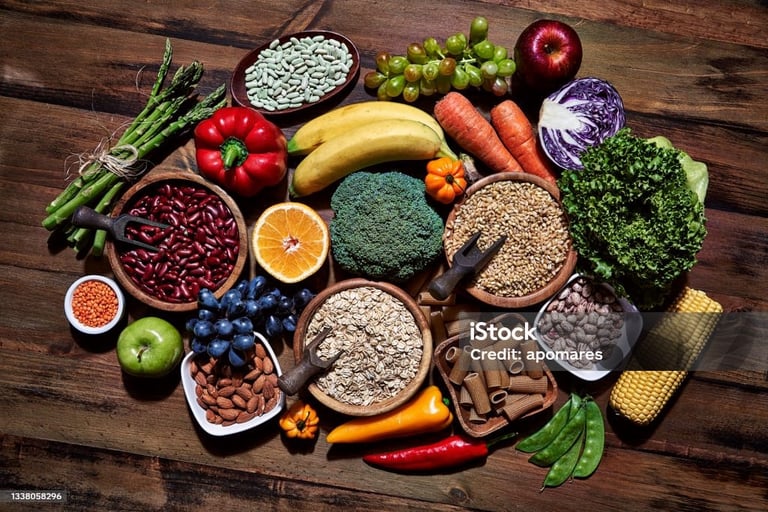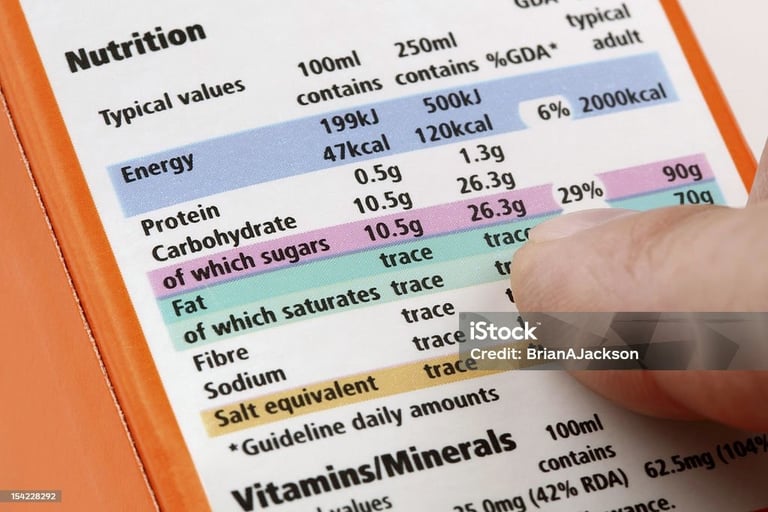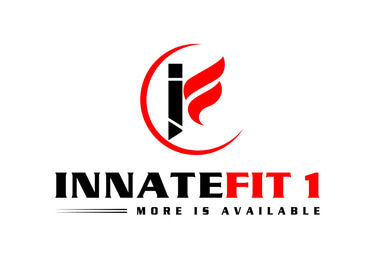Visit Innatefit1.com for exercise wear and equipment!!!
Decode Like a Pro: The Ultimate Food Label Checklist—10 Things to Scan Before Buying Any Packaged Food
Struggling to make healthy food choices? Decode packaged food easily with our Ultimate Food Label Checklist. Learn vital nutrition label tips for weight loss, fitness, and overall health today!
SELF-HELPHEALTHY LIFESTYLEFITNESS TIPSNUTRITION AND RECOVERYHEALTH
Joseph Battle
6/24/20256 min read


Introduction: Why Mastering Food Labels Is Key to Healthy Eating
Standing in front of a supermarket aisle filled with colorful packaging and tempting claims, it's easy to feel overwhelmed. Manufacturers go to great lengths to catch our eye and appeal to our taste buds. However, savvy consumers understand that the true treasure trove of nutrition information lies on the back of the package—the nutrition label.
Food label reading is the essential key to making genuinely nutritious choices, aiding weight loss, boosting fitness progress, and improving overall health.
Yet, beginners often make common mistakes and may unknowingly sabotage their fitness or nutrition goals. Misinterpreting serving sizes, being misled by marketing phrases, or overlooking hidden sugars can derail even the most well-intentioned plans.
Therefore, understanding the basics of food labels is essential. Equipped with the best nutrition label tips for weight loss and fitness, you'll confidently navigate the supermarket and choose the best foods for yourself and your family. FREE PDF CHECKLIST
To simplify your shopping experience, we've created a definitive checklist detailing the ten critical things you should always look for on food labels before adding any packaged food to your cart. As a handy bonus, you'll find a printable and downloadable checklist included at the end of this post, making it easy for you to keep these healthy eating tips at your fingertips every time you shop.
Decode the Serving Size: Don't Be Fooled by Small Portions
When you first glance at a nutrition label, one of the top mistakes beginners make when reading nutrition facts is misunderstanding the serving size. Companies often list deceptively small portion sizes to make their products seem healthier. For instance, those seemingly guilt-free snacks boasting only 100 calories might refer to serving sizes that are far smaller than you'd typically consume.
Constantly scrutinize the serving size first, adjusting mentally for your actual consumption patterns. If you typically eat double the listed serving size, simply multiply the nutritional values by two. Mastering this principle forms the cornerstone of smart food label reading, ensuring you understand exactly what you're putting into your body.
Total Calories: Know What's Fuel—and What's Overload
Calories have long been portrayed as dietary enemies, particularly for those seeking weight loss. However, calories are merely units of energy your body needs to thrive. What matters is choosing the right kind and quantity to fuel your body, not overwhelm it. Thus, carefully examining total calories per realistic serving size is the next vital step on our ultimate food label checklist.
Use label calories as guidelines rather than absolutes. For instance, a meal intended to sustain you for hours should have more calories than snacks offering momentary satisfaction. Awareness of calorie content will help you effortlessly regulate portion sizes and plan meals that support your fitness and health journey.
Learn to Spot Hidden Sugars: Sweet Sabotage Alert
One of the sneakiest threats to a healthy diet and fitter physique is hidden sugar. Food manufacturers cleverly disguise sugars behind obscure terms like maltose, fructose, or agave nectar, leading unaware consumers astray. Even seemingly health-conscious items, such as granola or sauces, often conceal hefty sugar loads, undermining your healthy eating tips and diligent diet efforts.
Always scan the ingredient list thoroughly for sugars under all aliases. Furthermore, checking the total sugar content (under carbohydrates) or the “added sugars” value, if listed separately, will reveal any hidden sugar traps. Remember this mantra: less is best when it comes to sugars, especially those added to supposedly nutritious foods.
Unmask Unhealthy Fats: The Good, The Bad, and Trans-Fat Ugly
Not all fats are created equal—some support heart health, while others wreak havoc on your wellness goals. Many beginners overlook the trans-fat content in snacks, yet these fats significantly increase the risk of heart disease and can negate fitness progress. Food manufacturers may use phrases like “0 grams trans fat” misleadingly, legally allowing small amounts—under 0.5 grams per serving—to escape reporting.
Don't be fooled! Carefully inspect ingredient lists for partially hydrogenated oils, the tell-tale sign of hidden trans fats. Favor products with unsaturated fats, such as those found in nuts, avocados, and olive oil. Becoming adept at detecting harmful fats will dramatically enhance your food label reading capabilities, ultimately promoting greater health and longevity.
Sodium Levels: Shaking Off the Salt Trap
Sodium is essential, but excessive intake can raise blood pressure, increase the risk of cardiovascular disease, and cause bloating that can mask fitness results. Surprisingly, much of our daily sodium intake stems not from table salt at home, but from packaged or processed foods. Foods like soups, deli meats, frozen meals, or crackers may pack deceptively high sodium levels.
When reading food labels, diligently evaluate the sodium content to stay under approximately 2300 mg daily (lower for specific health objectives). Choose "low sodium" versions, and always compare sodium amounts across similar products to make informed selections. Incorporating this strategy quickly becomes second nature, helping to keep your heart healthy and body lean.
Fiber Finds: Boost Your Health with Nature’s Broom
Fiber-rich diets enhance digestion, support weight loss, stabilize blood sugar levels, and promote gut health. Yet, sadly, many processed foods either eliminate natural fiber or possess too little. A simple yet powerful step in assessing the quality of packaged food is checking the dietary fiber content on nutrition labels. FREE PDF
Prioritize foods containing at least 3 grams of fiber per serving and select high-fiber snacks, breads, or cereals whenever possible. Awareness here easily elevates your diet’s nutritional profile and boosts overall health without any complicated calculations.
Proteins: Support Your Body's Building Blocks
Protein isn't just reserved for bodybuilders—it’s essential for everyday cellular repair, muscle maintenance, weight management, and satiety. Unfortunately, many processed snacks and treats are primarily high in carbs, refined, or low in meaningful protein—a missed nutritional opportunity.
On your label checklist, prioritize items that offer sufficient amounts of protein relevant to their product category. Snacks featuring at least 5 grams of protein per serving gain extra points, as protein leaves you fuller longer, reduces unhealthy snacking, and supports fitness objectives naturally.
Ingredient List Insights: Avoid Ingredient Overload
Savvy shoppers know shorter is better when it comes to an ingredient list. A long, complicated list filled with chemical names you can't pronounce signals heavily processed products rather than nutritional gems. Prefer prepared real-food alternatives containing ingredients recognizable to home kitchens.
Reading the entire ingredient list may initially seem tedious; however, developing this simple habit can rapidly enhance your awareness and discernment of genuinely wholesome foods. Soon, it becomes second nature—a clear sign that you're on a strong, sustainable, and healthy eating path.
Vitamin and Mineral Content: Added Health Bonuses
Specific nutrients—vitamins A, C, calcium, iron, potassium, and vitamin D—appear prominently on labels due to their significant importance for health. Paying attention to these numbers can help you choose nutrient-dense products that boost immunity, bone health, and overall vitality.
Scan labels for meaningful percentages—ideally at least 10% daily value per serving or higher. Including nutrient-dense packaged food can give busy individuals a valuable health edge alongside well-rounded dietary habit.
Allergens and Dietary Preferences: Safety First, Satisfaction Always
Food labels typically denote common allergens, including peanuts, gluten, dairy, and soy. Awareness here isn't simply about preference; it's about personal safety—yours or your loved ones'. Whether managing food allergies, intolerances, or aligning products with dietary lifestyle choices (such as vegan, gluten-free, or organic), always double-check allergen warnings or specialty labels.
Your consistent attentiveness here ensures not only allergen control but also improved satisfaction and dietary enjoyment in the long term, cementing your status as a savvy consumer for life.
Bring It with You: Your Printable Food Label Checklist
To make informed packaged food choices as easily as possible, we've developed a readable, printable checklist that summarizes all these tips. Simply click the provided link below to download your instant reference PDF, bringing essential healthy eating tips directly into stores with each trip.
[Download Your Printable Food Label Checklist] https://online.updf.com/pdf/share?shareId=944110978625183744
Final Thoughts: Master Food Labels, Master Your Health
Leveraging your mastery of food labels substantially empowers your dietary success, fitness results, and overall confidence as a health-conscious consumer. Continue revisiting this guide frequently and share these essential healthy eating strategies with friends, family, or anyone interested in improving their nutrition. With your newfound knowledge of food labeling, thriving health awaits!




